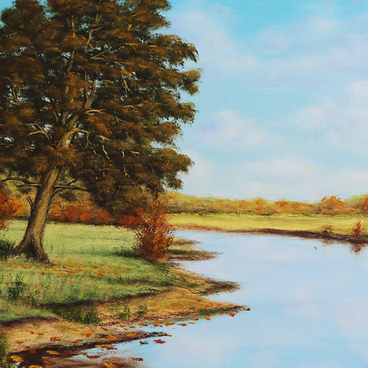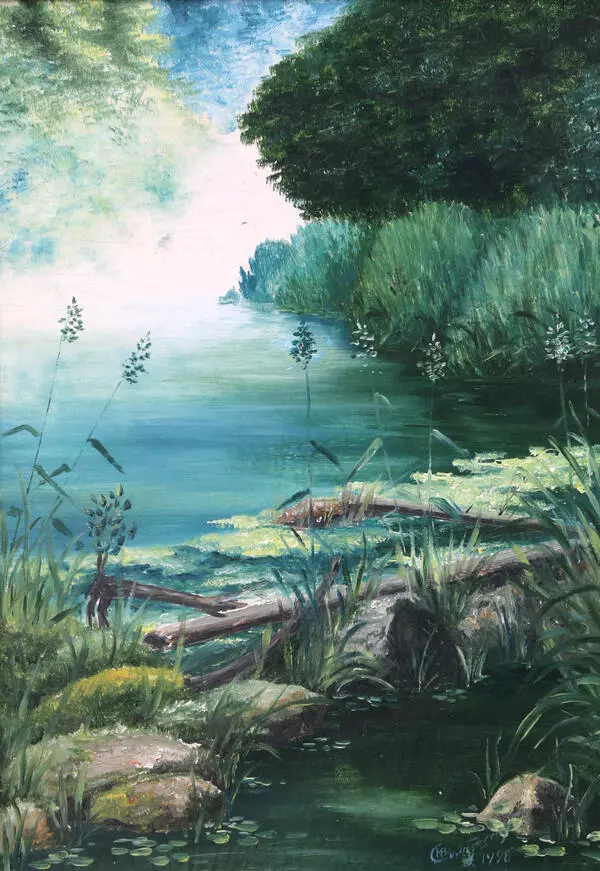Nikolai Vasilievich Soldatov was born in the village of Martovka, in Altai Territory. In 1970 he moved to Mezhdurechensk — which he chose just by looking at the map. He worked as an art teacher in a residential school. In 1974 he decided to work as a coal miner, and was employed at the Raspadskaya mine for 35 years.
Nikolai Soldatov started painting at the age of 14. His first teacher was a neighbor, a retired officer called Alexander Titov. When young Nikolai saw ‘Uncle Sasha’ working on a landscape painting, he stood watching him for two hours, fascinated. The same day, he asked his mother to give him a bed sheet that he could paint on, and he made his own brushes out of hairs from a horse’s mane.
Later on, the young artist sent off for paints and two sets of brushes from Novosibirsk — at a cost of a hundred roubles. He got up at the crack of dawn to go to the post office to fetch his long-awaited parcel. He was the happiest person in the world. He learned to paint from works by Shishkin, Aivazovsky, and Polenov, and copied Vasnetsov’s historical paintings.
Nikolai Soldatov painted fine still-lifes, and highly expressive portraits and genre compositions. But landscape painting was always dearest to his heart. He frequently participated in city and regional plein-air painting
competitions, and loved to paint from nature. In his paintings he depicted the beautiful scenery and magnificent nature of the Mountain Shoria region. He had the rare gift of being able to depict subtle effects of light, shadow and tone, from the sparkling snow, with its many gradations of white, to the crystal transparency of mountain rivers and lakes and the bright, saturated colors of summer. In all his pictures we can feel the breath of life. His landscapes stand out for their technical accomplishment and their profoundly poetic atmosphere. When people look at his paintings, they ask themselves — ‘Where is this beautiful place? ’
In Evening on the Tom the painter depicts a dazzling sunset over the river. The low sky, tinged with the hues of the evening sun, is reflected in the calm water. The last rays of the setting sun have tinted it a golden color.
Mirror-like, the river reflects the violet and dark blue clouds, which give the sky a fantastic, mysterious and majestic appearance. The left bank of the Tom is almost entirely hidden in darkness, with only a few treetops reflecting the light of the setting sun. But on the right bank it is still light. In the background, we see the forest merging into a line of hills. The painting is full of air and space. The bright, vivid colors and the combination of the smooth texture and the pointillistic brush strokes give the painting a photo-realistic quality.
Nikolai Soldatov started painting at the age of 14. His first teacher was a neighbor, a retired officer called Alexander Titov. When young Nikolai saw ‘Uncle Sasha’ working on a landscape painting, he stood watching him for two hours, fascinated. The same day, he asked his mother to give him a bed sheet that he could paint on, and he made his own brushes out of hairs from a horse’s mane.
Later on, the young artist sent off for paints and two sets of brushes from Novosibirsk — at a cost of a hundred roubles. He got up at the crack of dawn to go to the post office to fetch his long-awaited parcel. He was the happiest person in the world. He learned to paint from works by Shishkin, Aivazovsky, and Polenov, and copied Vasnetsov’s historical paintings.
Nikolai Soldatov painted fine still-lifes, and highly expressive portraits and genre compositions. But landscape painting was always dearest to his heart. He frequently participated in city and regional plein-air painting
competitions, and loved to paint from nature. In his paintings he depicted the beautiful scenery and magnificent nature of the Mountain Shoria region. He had the rare gift of being able to depict subtle effects of light, shadow and tone, from the sparkling snow, with its many gradations of white, to the crystal transparency of mountain rivers and lakes and the bright, saturated colors of summer. In all his pictures we can feel the breath of life. His landscapes stand out for their technical accomplishment and their profoundly poetic atmosphere. When people look at his paintings, they ask themselves — ‘Where is this beautiful place? ’
In Evening on the Tom the painter depicts a dazzling sunset over the river. The low sky, tinged with the hues of the evening sun, is reflected in the calm water. The last rays of the setting sun have tinted it a golden color.
Mirror-like, the river reflects the violet and dark blue clouds, which give the sky a fantastic, mysterious and majestic appearance. The left bank of the Tom is almost entirely hidden in darkness, with only a few treetops reflecting the light of the setting sun. But on the right bank it is still light. In the background, we see the forest merging into a line of hills. The painting is full of air and space. The bright, vivid colors and the combination of the smooth texture and the pointillistic brush strokes give the painting a photo-realistic quality.



